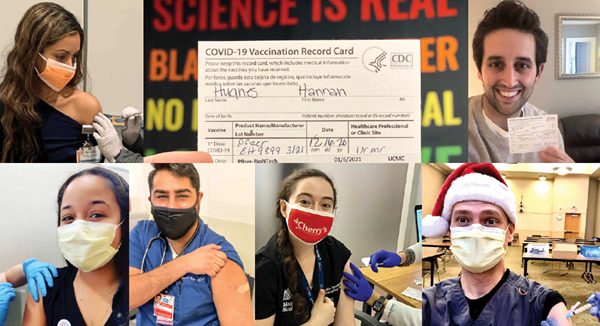Happy new year EMRA Family!
I hope the holiday season was a time of renewal and time that was well-spent with loved ones. We are starting a new chapter together, and I am looking forward to seeing how we can continue to progress towards a brighter and more social future.
As terrible as 2020 seemed to be at times, it was also a time for reflection and appreciation for me. I learned to appreciate the people near me and reconnect through virtual meet-ups with friends afar. I also understood the importance of maintaining and nurturing a feeling of connectivity and community with the people near you. At times, these people were my rock - often the ones I relied on when things became difficult. I appreciated the initiative shown by thousands of medical students around the country who gathered to help residents and attending physicians by volunteering for pet and childcare. Many such groups created grassroots student organizations to bring food and resources to impoverished neighborhoods, collect and distribute PPEs, and much more.1
However, the community that I have grown to appreciate the most is the scientific and research community. Both have been at the forefront of this pandemic. There has never been a time when a novel virus that ravaged the world was sequenced, studied, and understood down to its genetic makeup so quickly in the entire span of humanity's existence. The scientific community's advancements in the past 20 years, especially in terms of genome sequencing, helped forge this path.2
To truly appreciate the break-neck speed shaped by the research and scientific community's tireless effort, we need to quickly explore how long vaccine creations have taken in the past. Chickenpox vaccine took approximately 28 years to develop,3 while HPV and rotavirus both took 15 years.4,5 The 15-year timespan was thought to be an advancement at that time! The COVID-19 vaccine was created and distribution started in less than a year!
There are many reasons why the COVID-19 vaccine was manufactured within a year of the virus's first entrance into human-to-human transmission.
- Genetic sequencing allowed scientists to understand the virus in its most intimate form in record time. This technology, until recently, was just not available or feasible.6
- The way the vaccines have been manufactured was changed with the COVID-19 vaccine. In the past, a weaker version of a virus or part of its protein was used to manufacture the vaccine. The downside to this approach was its imperative to grow in eggs or cells - which were time-consuming and expensive. In contrast, the mRNA vaccine produced by Pfizer and Moderna was made using a surface protein found on the COVID-19 virus, which is coded to make Spike glycoprotein.7
- Vaccines typically go through safety, efficacy, and comparison trials, subsequently listed as phases 1, 2, 3. COVID-19 vaccine phases combined its second and third phases while making sure safety remained untouched.8
- Lastly, the recruitment of patients for the COVID-19 vaccine, unlike other vaccine trials, had such an overwhelming response for trial participants that it helped save time.8
The efforts listed above show how the research and scientific community saved humanity and provided us a glimpse of hope that we have all been coveting for the past several months. We, at the EMRA Board, have been so thankful and proud to have received our vaccines. I understand there are still some hesitant residents and medical students who are wary of the vaccine. We stand together as a community. As physicians and future physicians, you are seen as the leader in the department and the community.
Please be the change you want to see globally, do your research, and I encourage you all to get the vaccine.
References
- University of Michigan School of Public Health. From Hashtag to Global Movement: Students Against COVID-19. Sept. 10, 2020.
- Baragona S. 20 Years On, Human Genome Project Helps Drive COVID-19 Research. VOA News Science and Health. June 26, 2020.
- Pediatrics on Demand. History of Chickenpox and How the Vaccine Changed Everything. July 8, 2020.
- Kim SY, Sweet S, Chang J, Goldie SJ. Comparative evaluation of the potential impact of rotavirus versus hpv vaccination in GAVI-eligible countries: A preliminary analysis focused on the relative disease burden. BMC Infect Dis. 2011;11(2):174.
- Offit PA. A Look at Each Vaccine: Rotavirus Vaccine. Children’s Hospital of Philadelphia. May 18, 2020.
- Castro CJ, Marine RL, Ramos E, Ng, TFF. The effect of variant interference on de novo assembly for viral deep sequencing. BMC Genomics. 2020;21(1):421.
- Michelson A. How the coronavirus vaccine development compares to other shots in history. Business Insider. November 19, 2020.
- Ball P. The lightning-fast quest for COVID vaccines - and what it means for other diseases. Nature. December 18, 2020.



